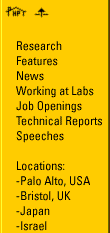| |
HP Labs Technical Reports
Click here for full text:

The Theory of Two-Electron Atoms: From the Ground State to Complete Fragmentation
Tanner, Gregor; Richter, Klaus; Rost, Jan-Michael
HPL-BRIMS-98-17
Keyword(s): two-electron atoms; quantum chaos; electron- correlation; review
Abstract: The evolution of understanding and predicting spectra of two-electron atoms including doubly excited resonance states which are strongly influenced by correlated electron-electron dynamics is reviewed. In a first part we summarize the historical development and introduce common techniques to measure and calculate two-electron atom states. Part two gives an introduction into approximate quantum methods developed for two-electron atoms, in particular adiabatic and group theoretical approaches. These methods explain and predict the striking regularities of two-electron resonance spectra by identifying approximate quantum numbers corresponding to collective, correlated electron-pair dynamics. The quantum numbers are very different from the independent particle classification, suitable for low lying states in atomic systems, only. Part three describes modern semiclassical concepts and their application to two-electron atoms. Simple interpretations of the approximate quantum numbers can be given in terms of a few key periodic orbits of the classical three body problem. Qualitative and quantitative semiclassical estimates for doubly excited states are obtained for both, regular and chaotic classical two-electron dynamics using modern semiclassical techniques. Notes: Klaus Richter, Max- Planck Institut fur Physik Komplexer Systeme, Nothnitzer Str. 38, D-01187 Dresden, Germany. Jan- Michael Rost, Fakultat fur Physik der Universitat Frieburg, Hermann Herder Str. 3, D-79104 Freiburg, Germany
84 Pages
Back to Index
|




